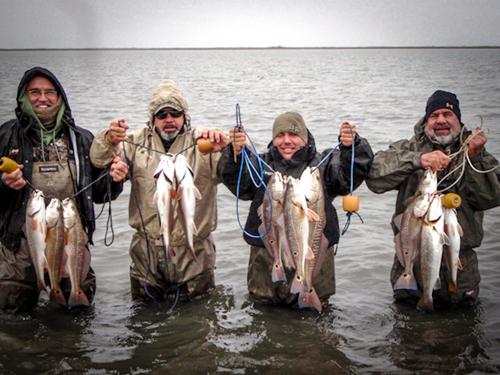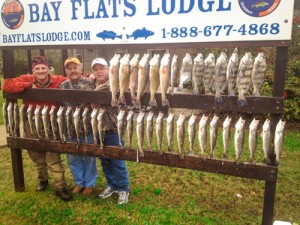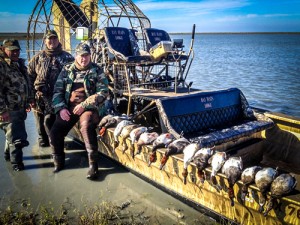
Bay Flats Lodge Capt. Nathan Beabout using lures, picked up reds all day long, “We never got cold because we were always catching.”
I love fishing, and I love cooler weather. Therefore, as a coastal angler, I enjoy January. It’s a month of transition for so many things, so it seems to be anything but a boring month for so many reasons. For one, water temperatures begin to fall drastically, changing from that of cool to that of cold. Because of this, the fish behavior also undergoes change this month as the fish begin acting as though they have stage fright and lockjaw. They suddenly become very selective eaters and can be very hard to entice using the things that worked for me over the past few months when it was warmer. And the places where the fish hangout also changes this month, as the fish begin looking for a steady food supply above mud, or shell, or both, instead of above sand and grass as they did during the summer and fall months. As a result, January generally marks a time of the year in which I, too, am required to change in order to be successful while fishing for cold-water fish.
From a tactical standpoint, there’s a list of things I do differently when fishing during colder months of the year. And things like slowing my retrieve to facilitate lethargic fish, throwing dark-colored lures to provide the preferred silhouette, using fluorocarbon instead of monofilament to enhance casting distance, and performing different styles of rigging to entice a strike are all standard items on the list. But, probably the two biggest changes I make to my fishing habits for the month of January are the species of fish that I like to target, and the structure over which I target them. I’m talking about cold-weather redfish that I find many times in January whenever I’m fishing over shell that’s textured with mud, or a very soft and muddy sand mixture.
Now then, I may need to clarify a couple things here regarding shell before I go any further. When I say the word “shell” in reference to January redfish, I’m not just talking about the large-sized oyster shell that we’re ever so accustomed to finding in the form of reefs, or pads, located at various intervals throughout the bay floor or along shorelines. When hunting these fish in cold water, it has become customary for me to make an effort to pinpoint any kind of shell – pieces of outer-body shells from any other mollusks that are typically found in our bay systems, like that of mussels or clams. This has become an obsession of mine over the years that has allowed me more success than failure when searching for reds once the water has turned really cold.
How do I find these shell-rich locations? The answer is simple, but the effort can prove to be very time consuming – I’ve spent endless hours scouting (and walking) newly exposed bay floor areas during periods of extreme low tide, like the days immediately following the passage of strong wintertime cold fronts. The weather doesn’t always fully cooperate on such days, and you can spend the entire day with freezing hands and cold ears, but the rewards can be astronomical if you’re willing to put in the time and effort to cruise around and mark-up and make notes on one of your favorite hot spot fishing maps.
A lot of area drains leading out of the back lakes and into the main bay system are always good places to start looking for small, submerged oyster shell patches. If I find some of these smaller oyster pads that happen to be situated near the mouth, or opening, where the drain empties into the bay I like to position myself on the bay side within casting distance of the mouth during a somewhat strong falling tide. This allows me to retrieve my bait in a natural fashion while utilizing the flow of the outgoing current to my advantage. I’ve often found these reds to just be sitting idle while hovering over the oyster pads at the drain openings as they simply wait for their food source to be swept within striking range. Depending on how cold the temperature actually is, the strike can sometimes be very minimal, resembling nothing more than your bait rubbing against one of the oyster shells as it slowly moves across the bay bottom. When this is the case, I like to slowly lower my rod tip and reel-in any slack that may be in my line before attempting to set the hook, as it’s very easy to miss these fish when they’re hitting like this.
Some of my favorite wintertime fishing for reds, however, still comes from areas located in the upper end of San Antonio Bay that are adjacent to the lower stretches of the Victoria Barge Canal. It’s an upper bay delta area that historically has been more brackish in nature than that of the vast expanse of San Antonio Bay itself. Although there’s a wide variety of shellfish species found in the neighboring bays and rivers, there are two species in particular that serve as primary food sources in this area for redfish and for trout. One is the eastern oyster that is commonly found in low-salt environs. The other one, the one that’s really popular amongst the redfish, is the rangia clam which is found mostly in brackish surroundings. And as we all know, the redfish can tolerate brackish water quite well, and they have a habit of feeding on mollusks and crabs in very shallow water. But for reasons unknown to me, the redfish love these clams during periods of cold weather. I’ve actually witnessed schools upon schools of redfish feeding in these areas on any given day when the water gets extremely cold beginning in January.
I realize that looking for different types of shell may not require a lot of finesse, and that a lot of anglers may not consider it to be a glamorous task, but doing so can be quite effective. For those of us willing to spend the time, and the effort, to fully grasp this simple technique, the reward can be nothing less than truly amazing when hunting for wintertime redfish in January along our coastal regions. Here’s to hopes of a very prosperous, safe, and Happy New Year for us all…!
Captain Chris and Deb Martin
Owners, Bay Flats Lodge, Inc.
www.BayFlatsLodge.com
BayFlatsLodge@gmail.com
Buy your Fishing or Hunting License before arriving call 1-800-895-4248 or http://www.tpwd.state.tx.us/business/licenses/online_sales/index.phtml
For a nice article about duck hutning in Seadrift, Capt. Chris Martin recommends:
http://www.outdoorlife.com/blogs/hunting/2013/01/redhead-paradise-duck-hunting-texas-coast

Bay Flats Lodge Captain Rick Hammond; element of surprise, stays out till 5PM, and that extra effort paid off for Mark R. party Jan. 8, 2013 San Antonio Bay with live shrimp

